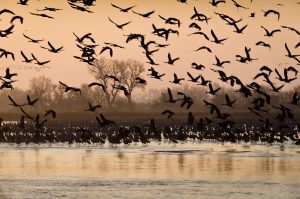The following is excerpted from my book, Beaks, Bones, and Bird Songs.
 Migration is dangerous but it must be advantageous for long term survival. Determining how the physical and physiological characteristics of organisms developed over geological time is difficult as the fossil record is incomplete and the fossils themselves often lend themselves to debatable interpretations. Establishing the evolution of a behavior is even more challenging but we can make some guesses. Since many bird species adopted migratory behavior, it must have proven more beneficial than being sedentary (non-migratory). It might be that a sedentary population of birds breeding prolifically eventually fills a habitat and competes ever more strongly for resources such as food and nest sites. To insure their own survival, some of the younger birds might move to another area, possibly marginal in resources but with less competition, and establish their own population. If the new area is in the northern hemisphere, it might become unsuitable in the winter, so these northern birds return south to the sedentary population, along with their young. This movement lessens competition for resources for the entire population during the breeding season and competition during the winter season may not be quite as intense. The following year, the population of migratory individuals along with their offspring moves northward again, perhaps occupying an even larger area. As the years go by, the sedentary population, being invaded in the winter by an ever larger migratory population, eventually succumbs to competition from the migrants, resulting in an entirely migratory population.
Migration is dangerous but it must be advantageous for long term survival. Determining how the physical and physiological characteristics of organisms developed over geological time is difficult as the fossil record is incomplete and the fossils themselves often lend themselves to debatable interpretations. Establishing the evolution of a behavior is even more challenging but we can make some guesses. Since many bird species adopted migratory behavior, it must have proven more beneficial than being sedentary (non-migratory). It might be that a sedentary population of birds breeding prolifically eventually fills a habitat and competes ever more strongly for resources such as food and nest sites. To insure their own survival, some of the younger birds might move to another area, possibly marginal in resources but with less competition, and establish their own population. If the new area is in the northern hemisphere, it might become unsuitable in the winter, so these northern birds return south to the sedentary population, along with their young. This movement lessens competition for resources for the entire population during the breeding season and competition during the winter season may not be quite as intense. The following year, the population of migratory individuals along with their offspring moves northward again, perhaps occupying an even larger area. As the years go by, the sedentary population, being invaded in the winter by an ever larger migratory population, eventually succumbs to competition from the migrants, resulting in an entirely migratory population.
Most explanations of the evolution of migration involve some version of three hypotheses: 1) competition among individuals in the sedentary population, 2) climate change, or 3) predation by increasing numbers of invaders. Seemingly simple, these premises are confounded by factors such as the birds’ diet, body mass and structure, habitat, energy required for flight, and other factors.
It appears that patterns of migration developed almost randomly and that the migratory habit is elastic. We once assumed that today’s migratory bird populations all evolved from sedentary populations, implying that migration is an evolutionary advancement to enhance survival. But a recent study of the wood-warbler family of North and South America reveals that the ancestral wood-warbler was migratory and that the loss of the migratory habit – becoming sedentary again – was as frequent as becoming migratory, a case of regressive evolution, like flightlessness. But why do some species migrate but similar species do not? Why do some individuals of a species migrate and others not, and why is it that one individual may be migratory one year and sedentary the next? Both genetic and environmental components are at play here, but their roles have yet to be sorted out. So I’ll conclude by simply saying that the migratory habit must be advantageous to the 40 percent of extant birds that participate in it.
Read Scott Weisensaul’s outstanding book, Living on the Wind: Across the Hemisphere with Migratory Birds.
Thanks a lot!